I wrote “The Way Forward for Canadian Digital Diplomacy” for Canada’s The Embassy on November 18, 2015. I followed this up with a list of more specific about steps that Global Affairs Canada might take in developing Twiplomacy if this direction were to be embraced. Another version of this came as “Five Rules to Guide the Future of Canadian Digital Diplomacy“, and then I mused about criteria by which the Canadian government might decide which digital diplomacy strategies to go ahead with. Below is a revision of my list of “Many Habits of Successful Digital Diplomats” for Mongolia.
What is Digital Diplomacy?
Much has been written about Digital Diplomacy (or Twiplomacy, or Diplomacy 2.0), but at its most basic level such a strategy aims to harness the power of new electronic and information technology tools to further the interests of a country. Most prominent in the Twiplomacy toolbox are networked social media, but various big data-driven initiatives are also included in this overall category. While notions of Digital Diplomacy originated in North America, it has spread much beyond, including to Northeast Asia.

Design by Cameron Tulk
Why Mongolian Digital Diplomacy?
It’s worth mentioning why Digital Diplomacy might be of particular interest to the Mongolian government.
- Mongolians have become active and natural digital communicators;
- the 3rd neighbour policy (I’m trying to establish #3NP) targets virtual neighbours already;
- Mongolia’s strongest case for its relevance is its status as Asia’s post-state socialist democracy, a claim that can be reinforced through a concerted Digital Diplomacy strategy and leverages the democratic instincts of online communication;
- digital diplomacy can be relatively cost-effective at a time of state budgets under pressure;
- Mongolians in general and Mongolian diplomats in particular are polyglot, so they are able to address audiences in many different languages.
In his analysis of the network of Twitter links between ministries of foreign affairs, Oxford University’s Ilan Manor has found the Twitter account of Mongolia’s MFA to be somewhat isolated.
Note that Mongolia appears in the bottom left corner here. As you can see all the links at the time of Manor’s analysis were in-bound, i.e. other MFAs linked to Mongolia’s, but the Mongolian MFA didn’t link to other MFAs.As Mongolia’s missions have recently made a big push to create Twitter accounts, this lack of strategic linking by the HQ account is certainly a missed opportunity.
So, here is my revisions of the “The Many Habits of Successful Canadian Digital Diplomats” for Mongolia’s Ministry of Foreign Affairs.
The Many Habits of Successful Mongolian Digital Diplomats
Process and Management
- firmly distinguish broadcast use from engagement, identify channels by use;
- select areas of engagement strategically, building on overall foreign policy;
- think, write, engage, review, repeat;
- learn qualitatively and quantitatively from communicating;
- remain platform agnostic, but include different formats. Current standard formats would include micro-blogging and blogging.
People
- embrace facility with vernacular languages as engagement is more likely (though not exclusive to) vernacular languages;
- digital diplomacy should be run by diplomats not social media specialists;
- emphasize work-life balance, engagement cannot lead to expectation of 24/7 communications;
- recognize distinctions between individuals’ and institutional presence (e.g, ambassadors vs. embassies), as they can mutually reinforce visibility, but also detract from strategic objectives;
- engagement requires passion;
- diplomacy has always been social and always involved networks! Actively engage foreign diplomats, most active stakeholders;
- integrate Digital Diplomacy into job descriptions, hiring decisions, evaluations, and promotions, but not in a punitive way. Not all positions require Digital Diplomacy skills and lots of contributions will continue to be made by analog diplomats;
- empower, support and coordinate the efforts of experimenters and pioneers.
Substance
- all digital diplomacy activities are rooted in substance, no communication/engagement for communication’s sake;
- obvious choices for engagement: overarching thematic priorities for foreign policy; aspects of foreign policies aimed squarely at digital matters, e.g. membership in Freedom Online Coalition, Community of Democracies, Land-Locked Developing Countries, etc.;
- embrace the reflective nature of communication and the opportunities this offers;
- not all countries are equally well-suited for engagement, nor is it needed or likely to be beneficial everywhere;
- lots of subject matter is neither suited for engagement, nor should it be. The weighing of foreign policy options is sometimes conducted in private and that is how it should be;
- stakeholders’ expectations have to be managed through forthright statements on their impact. Some engagement will not change policy, some policy decisions will contradict a consensus among stakeholders.
Mongolian
- build on Mongolian foreign policy by developing a strategy built around democratization;
- seek, use, nurture Mongolian format innovations, perhaps through the International Cooperation Fund of the Min of Foreign Affairs;
- seek, use, nurture Mongolian technology/business innovations through an office/division that focuses on tech adoption. Given the vibrancy of the social media scene in Mongolia, there’s no reason why one of the next innovations might not come from here;
- embrace polyglot talents of Mongolian(s) diplomats;
- Digital Diplomacy is appropriate to a small power, particularly when resources at Mongolian ministries are tight.
Suggestions for Possible Themes to Build Digital Diplomacy Around
- democratization;
- impact of climate change;
- resources and experiences with global investment from vantage point of developing country/resource economy;
- Northeast Asia, including Ulaanbaatar Forum
- Mongolian leadership
- ASEM 2016 (Twitter account exists, but very much in broadcast mode, not engagement)
- UN Security Council candidacy for 2022: making a case for presentation of land-locked developing countries, democratized countries, small countries, etc.


 Follow
Follow
These are really great. I hope Mongolian diplomats learn these skills and strategies. These diplomats can learn a lot from some very successful Mongolians on Twitter.